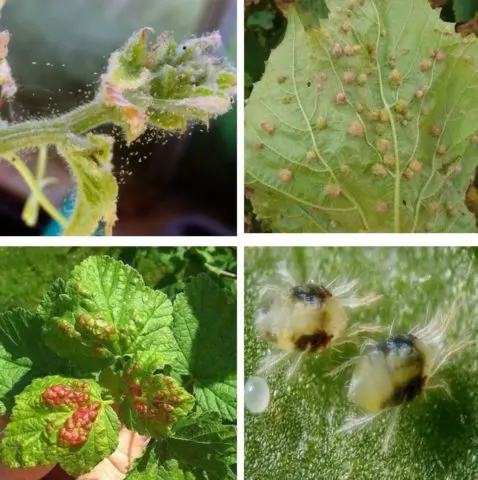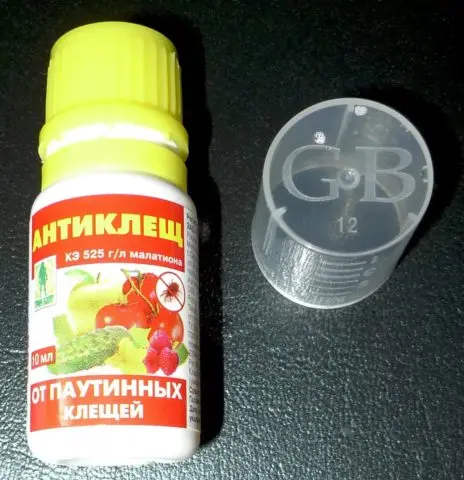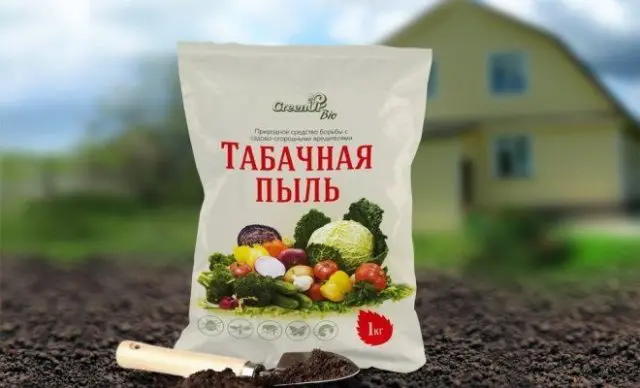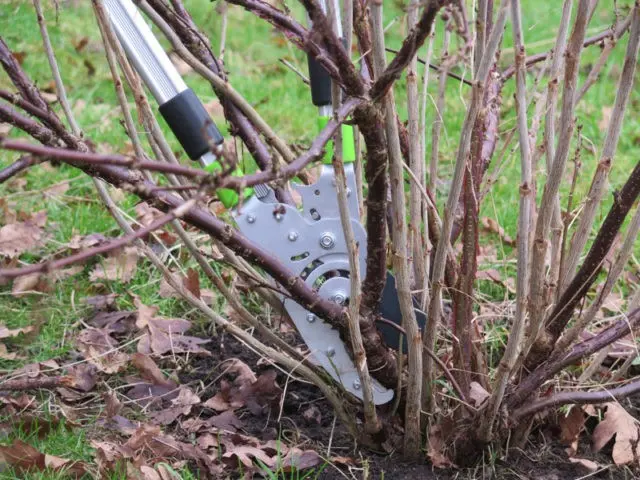Contents
Pests cause serious damage to berry bushes. Among them, one of the most dangerous insects is the spider mite. The pest feeds on the sap of the plant and inhibits its development. Spider mites on currants can appear at any time during the summer season. Special preparations, folk remedies, and compliance with agricultural technology help to fight it.
Signs of a spider mite on a currant
The spider mite is a member of the spider family. Its dimensions are from 0,25 to 0,4 mm. The body of the insect is oval. Females are gray-green in color, which changes to red-orange by the end of the season. Males have an elongated body.
The pest overwinters in the bark of shrubs and plant debris. It dies at temperatures below -28 °C. In the spring, after warming, the females leave the shelter and move to the lower part of the leaves, and then they begin to weave a thick web, where they lay their eggs.
For a period of 8 – 20 days, a new generation appears. At first it lives on weeds: nettle, swan, plantain. In the middle of summer, the pest moves to berry bushes, including currants.
Spider mites are identified by a number of signs:
- thin web on shoots and berries;
- chiseled white spots on the leaves, which eventually become marbled and brown;
- twisted sheet plate;
- premature drying and falling of leaves.
Photo of a spider mite on a currant:

What is dangerous spider mites on currants
The spider mite is dangerous at all stages of its development. The pest pierces the leaf plate and feeds on plant sap. In this case, chlorophyll grains are lost. As a result, the leaves lose their color, and their cells die. Gradually, the lesion spreads over the entire surface.
Under the influence of insects, the currant loses its decorative appearance. Its leaves dry up and fall off. The bush does not receive the necessary development, and its growth slows down. With a serious lesion, the plant may die from a lack of moisture.
Spider mite causes serious damage to crop yields. If the pest appeared before the formation of the ovaries, then fruiting can be reduced by 30 – 70%. If it is found when the berries ripen, then there are chances to save the crop.
The distribution area of the pest includes Europe, Asia, America and Australia. It is also found in the Far North. If measures are not taken in time, the tick will move to other plants. Not only currants are at risk, but also other crops: apple, gooseberries, strawberries, all stone fruits.
Remedies for spider mites on currants
There are various methods to get rid of the pest. Chemical preparations are considered the most effective. In addition to them, natural substances and agricultural techniques are used against insects.
Chemicals
The basis of chemicals against ticks is paralytic poisons. When a pest enters the body, they suppress the activity of nerve cells. As a result, paralysis and death of the insect occurs.
Chemical agents are characterized by a rapid effect on the body of insects. If the dosage is observed, they are safe for humans, plants and bees. Active ingredients quickly decompose in the soil.
For the treatment of currants from spider mites with preparations, a working solution is prepared. Be sure to observe safety precautions: use protective equipment for the eyes and respiratory organs. Children and animals are removed from the place of work. To spray the solution, take a spray bottle. It is best to process on a cloudy dry day. In sunny weather, choose the morning or evening period.

Folk remedies
From spider mites on red currants, folk methods help well. They contain only natural ingredients that do not contain hazardous chemicals. Such products are completely safe for people and animals. This includes wood ash, tobacco dust, infusions of various herbs.
Spider mites are repelled by strong odors. Therefore, to combat it on the currant, plants are chosen that have this property. The most effective remedies are from wormwood, dandelion, celandine, onion or garlic.
Folk remedies have no restrictions on use. They are used at any stage of development of the currant bush. Preparations based on natural ingredients are a good pest prevention.
Biological methods
Biological means involve the use of natural enemies. These are predatory insects – phytoseiulus and amblyseius, which feed on other insects. During the day they destroy up to 100 individuals.
This method is expensive, so it is rarely used in private farms. Predatory mites are bred in bran or vermiculite. They develop rapidly at high humidity and temperatures from +25 °C.
Phytoseiulus spreads within 7 to 9 days. The female lives up to 25 days and lays up to 5 new eggs. New insects appear from them, which destroy the next generations of mites on currants.
Agrotechnical measures to combat spider mites on currants
Measures to combat spider mites on blackcurrants begin with agricultural technology. Often a pest appears when the rules for caring for bushes are violated.
First, they turn to the mode of watering the bush. Plain water will help to cope with the pest. Insects do not tolerate high humidity, which reaches 90% or more. Therefore, the bushes are sprayed every 2 – 3 days. The procedure is carried out in the morning or in the evening, when there is no direct sunlight. If you spray the bush in the heat, the leaves will get burned. Be sure to use warm settled water.

To combat the tick, it is important to change the feeding scheme. Fertilizers containing nitrogen become a favorable environment for the development of insects. Therefore, they are used only in early spring. In summer, currants are fed with phosphorus and potassium substances. Such fertilizers will increase the immunity of the bush and help it recover from the attack of ticks.
In the course of pest control, organics and preparations containing phytohormones and amino acids are abandoned. These substances contribute to the active reproduction of the tick on plants.
How to get rid of spider mites on currants
When choosing a product, the stage of currant vegetation is taken into account. Before flowering, chemical or biological preparations are used. During the fruiting period, they switch to folk remedies.
How to process currants from spider mites before flowering
Before flowering, currants are treated with chemicals. They help to quickly cope with the pest and save future ovaries. Below are the main preparations for spider mites on currants:
Karate Zeon
Works against many garden pests. It has a paralytic effect on insects that die within 24 hours after spraying. The waiting period is up to 40 days. The product is not washed off by rain.
Anti-mite
A reliable remedy against various types of ticks. Processing is carried out before the appearance of buds and after harvesting the berries. The interval between sprayings is 10 days. The consumption of the drug is 1 ml per 1 liter of water. The resulting solution is enough to process 5 bushes.

Phytoverm
The drug does not penetrate the leaves and berries. As the temperature rises, its efficiency increases. Consumption is 0,08 ml per 1 liter of water. This amount of solution is enough to process one bush. The interval between treatments is 2 – 3 weeks.
Akarin
An effective preparation for different types of cultures. It has a high impact speed. The insect dies within 8 hours. To combat spider mites on currants, a solution is prepared in the spring. 2 ml of insecticide is enough for 4 liters of water. The solution is enough to process an adult bush.
How to get rid of spider mites during fruiting
When the berries ripen, they refuse chemicals. It is best to use natural enemies or folk remedies.
Below are the popular options for processing currants during fruiting.
Bithoxybacillin
Biological preparation of wide impact. Does not accumulate in berries and leaves. The waiting period is 5 days. To spray currants from spider mites, prepare a working solution with a concentration of 1%. Wait 15 days between treatments.
Dandelion infusion
500 g of fresh roots or leaves are collected in a bucket of warm water. The remedy is insisted for 3 hours, after which it is filtered. The infusion is not stored, but immediately used on currants.
Tobacco dust
10 g of dry tobacco is added to 350 liters of water. After a day, the mass must be boiled and diluted with the same amount of water. To keep the product longer on the leaves, add 50 g of crushed soap.
Infusion on onion skins. A large bucket of water requires 200 g of husk. The product is left for 5 days. Then it is filtered and used for spraying.

Soap solution
It is best to choose sulfur-tar soap. First, it is crushed with a knife or grater. Add 100 g of the resulting mass to a bucket of water. The solution is thoroughly mixed, then proceed to spraying the shrub. The treatment is repeated in a week.
Preventive measures
Annual prophylaxis will help protect currants from spider mites. This includes compliance with agricultural technology and preventive treatments. In autumn, fallen leaves are removed from the site, in which the pest hibernates. The soil under the shrubs is dug up so that the females of the parasite are on the surface. When cold weather sets in, they die.

Spring prevention includes spraying. Use drugs Fitoverm or Bitoxibacillin. Processing begins in early spring to destroy the pest before the larvae appear.
In spring or autumn, currants are cut to avoid thickening of the bush. Nitrogen fertilizers are applied before flowering, after which they switch to phosphorus and potassium compounds. Weeds are regularly weeded in the trunk circle.
Conclusion
Spider mites on currants appear during the growing season of berry crops. The pest causes serious damage to the bushes. When choosing a method of struggle, the condition of the bush and the time of year are taken into account. Be sure to observe agricultural technology, which will help to quickly get rid of the pest.









